After Minnette…
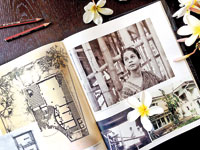
Minnette de Silva in her autobiographical book. Pic by Ishanthi Gunawardana
If any of that sounds commonplace, then that is testimony to Minnette’s success. And yes, this was all before the great Geoffrey Bawa.
Twenty years following Minnette de Silva’s death and with momentum slowly gathering for a long overdue celebration of her much neglected achievements, I’m shining a light on some of today’s female architects in Sri Lanka whose ideas and works have to my mind been as inspiring as Minnette’s.
These architects – Hirante Welandawe, Amila de Mel, Ruchira Wickramasinghe, Nela de Zoysa and Christine Wallbeoff – have a few things in common with Minnette de Silva: a commitment to contemporary perspectives of traditional Sri Lankan vernacular architecture, a strong sense of designs befitting the local environment and an uncompromising determination to succeed in their endeavour.
In many ways they still grapple with the same issues as Minnette, whether that be designing buildings suited to Sri Lankan climatic conditions or staking a claim in a still male dominated profession. However, their responses to those challenges are as diverse as they are edifying.
* * * * *
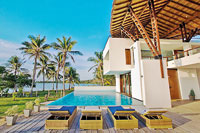
Hirante Welandawe’s – Villa Santé. Pix by You’re My Favorite
Hirante Welandawe
From the moment I met Hirante Welandawe it was clear that she was interested in the social aspects of design and how communities are integrated into their lived environment. Her participation in early 2018 in the Colombo Art Biennale led to a delightfully conceived sky garden being built amongst the most marginalised in Slave Island, Colombo. Her concept was of a shared, productive space for a close-knit community.
I couldn’t help but think that Minnette would have approved of her sky garden and its functional, community focus yet imbued with a sense of delight.

Hirante Welandawe
Hirante’s view of Sri Lankan built spaces also reveals a philosophical interest in design. She observes that traditional open spaces in Sri Lankan houses often reflect Sri Lankan culture where at times nothing is clearly defined. For example, a cultural predisposition to please frequently results in a “yes” to a question which could in fact mean “no” depending on how it was put, and people arrange their environment to accommodate this pervasive ambiguity.
It’s this sensitivity which she applies to all her designs.
In the post-war construction of a tranquil but inward-looking family home in Jaffna, Hirante oriented the house to respond to the security concerns, violence and continuing political polarisations which mar the community in which the family lives. And in a quiet revolution, the house is also built of locally sourced materials in a time when most building materials for the north are still transported from Sri Lanka’s southern regions.
On the other hand, the coconut leaf-shaped roof of the Villa Sante boutique hotel overlooking the Gulf of Mannar is a nod to the coconut plantation which once stood on the site whilst simultaneously being an ingenious contemporary perspective of a traditional high-pitched Kandyan roof. And the modern twist? The dramatic steps leading to the second floor of the hotel with sweeping water views is a homage to the monumental Villa Malaparte, also located on a promontory in Capri, Italy.
It’s little wonder that Hirante is consistently chosen as one of the top architects in the South Asian region.
Amila de Mel
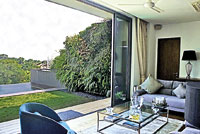
Amila de Mel’s Ebony Tree Apartments. Pix by Kshitija Venkatesh
I marvelled at the fact that Amila de Mel had worked directly with Geoffrey Bawa or “Mr Bawa” as she still respectfully calls him.
“He loved to create drama with his designs. There’s always chiaroscuro and a contrast between things: the falling apart and the pristine. He worked to carefully craft it all,” said Amila, who had worked with Bawa on the Kandalama Hotel from beginning to end. Amila still assists the Geoffrey Bawa Trust with major restoration work.

Amila de Mel. Pic by Luxshmanan Nadaraja
Of all the architects, however, I thought it was Amila who most closely channelled Minnette’s carefree and unconventional spirit. Her Mirihana home originally began its life as a couple of lived in, closely linked shipping containers (now long gone) whose footprint was consolidated to eventually form secure rooms for private spaces. Amila made use of an existing large, overhanging recycled metal shed to create a multi-purpose, permanent living space which wonderfully melds with the garden.
It’s a blurring of the inside and the outside very much in line with traditional Sri Lankan architecture but transported to the suburbs in a very contemporary way. If you’re still wondering how this space could possible work given the elements, Amila astutely observes that Sri Lanka’s climate does not have extremes, so you only need to solve for heat and rain and the rest is a question of lifestyle.
Amila’s penchant for drawing in the outside and combining that with lifestyle was taken to a new level in her recent the Ebony Tree apartment development for three brothers in central Colombo. Named after the ebony tree which Amila retained from the original site, the development is a modern take on a traditional way of living as an extended family where each brother occupies separate levels of the complex. Amila crafted the levels to give the feeling of a proper house (rather than just an apartment unit) reflecting the personality of that brother.
To me, this leads by example as an imaginative way of maintaining a “Sri Lankan house” within central Colombo in the face of recent frenetic growth in high density residential developments.
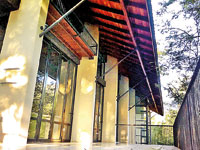
Ruchira Wickramasinghe’s Tamarind House. Pic by Ruchira Wickramasinghe
Ruchira Wickramasinghe
For Ruchira Wickramasinghe, designing a house starts simply with the roof. The roof sets the proportions for the house and proportions in a
Sri Lankan house, as Ruchira reminded me, is everything.
Like Minnette, Ruchira’s designs reveal her Kandyan roots. You only need to look at Ruchira’s “Pavillion Holiday House” project to catch glimpses of a royal Kandyan audience hall finished with a twist of Bawa-esque views of the surrounding mountains from every room in the house. This aesthetic is also connected to Ruchira’s personal ethos of simplicity in design and materials which in turn reflects the simplicity of tropical life in Sri Lanka. Perhaps Sri Lankans were minimalists long before that was a thing.
 The idea of simplicity translates in Ruchira’s architecture to minimal complexity of spaces, maximum use of Sri Lanka’s abundant natural light, vistas, and the use of local, natural finishes such as terracotta, cement and timber to realise modern sensibilities. To me, this echoes a building Minnette might have built – made with natural materials and to the scale of those who might use it.
The idea of simplicity translates in Ruchira’s architecture to minimal complexity of spaces, maximum use of Sri Lanka’s abundant natural light, vistas, and the use of local, natural finishes such as terracotta, cement and timber to realise modern sensibilities. To me, this echoes a building Minnette might have built – made with natural materials and to the scale of those who might use it.
Ruchira’s “Tamarind House” project was made almost entirely of polished concrete (floor and walls), recycled timber and energy efficient solar panels on the roof – the first house of its kind in the Central Province of Sri Lanka.
The thing which beguiles me however about both houses though is the way in which Ruchira uses architecture to create shadow from the intense Sri Lankan light. It’s more than just about keeping the sun out. That flickering of darkness captures a real Sri Lankan aesthetic and way of living and gives these houses a tranquility which is almost hard to define.
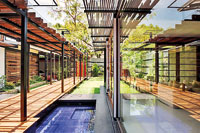
Nela de Zoysa’s House No. 8. Pic by Waruna Gomis
Nela de Zoysa
If there was anyone whose achievements have been as pioneering as Minnette’s then that person would be Nela de Zoysa.
The daughter of Justin Samarasekera (one of the founding fathers of the architectural profession in Sri Lanka and through whom Nela remotely knew Minnette), Nela hasn’t become the only Sri Lankan to win the coveted ARCASIA Gold Medal architectural award as judged by the Architects Regional Council of Asia, the first Sri Lankan female to receive the South Asian Architect Commendation Award and the only Sri Lankan after Geoffrey Bawa to receive an honorary fellowship of the American Institute of Architects, by being a shy and retiring violet. It has been the relentless pursuit of excellence in her work, a quick mind and an artistic flair (she likes to think of herself as an “artist architect”) which has bestowed these accolades on her.
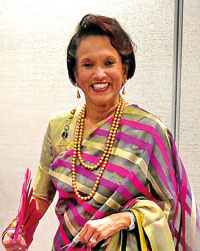
Nela de Zoysa
Nela is a true chameleon as an architect – from her home which is saturated with the filtered light and inside/outside spaces worthy of Bawa to the award-winning “House No. 8” built on a site needing to conceal an eye-sore and to her industrial complexes also winning awards for excellence in their own right.
House No. 8 doesn’t look typically Sri Lankan at first glance but on closer inspection you can see contemporary takes on pavilions, courtyards and the spatial fluidity in the design. It employs an internal courtyard as a source of ventilation as well as vista with the pavilions on either side almost floating on air around it. I particularly liked the incorporation into the building of the Ehela Tree next to the entrance. This willingness to make a building co-extensive with its natural environment, almost as if the two had grown together is something I have come to appreciate as quintessentially Sri Lankan.
The thing I found most arresting about Nela’s work though is her fantastic use of colour in her finishes. It punctuates the detail in her architecture and is probably attributable to her artistic skills (she did train early on with the inimitable Laki Senanayake). Either way, it’s a refreshing change from the whitewashed plaster common to Sri Lankan buildings.
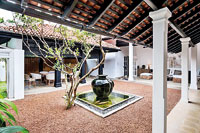
Christine Wallboeff’s Thalawathugoda House Pic by Waruna Gomis
Christine Wallboeff
Christine Wallboeff has the astonishing dual pedigree of being both a protégé of Geoffrey Bawa and Barbara Sansoni, Sri Lanka’s foremost colourist and textile designer, who Christine credits as also having a wonderful knowledge of architecture. It instilled in her a sense of contemporary Sri Lankan architecture which has been inspired by both the traditional and the modern.
Christine’s designs somehow retain the signature aesthetic details of traditional Sri Lankan architecture like the verandah columns and intricate carvings of the wooden friezes atop doorways and walls. But it’s her training with the modernist Bawa which gave her a real sense of simple lines and free flowing movement inside a building, the careful emphasis of voids between mazes, the play with light and shade and the very dramatic creation of vistas. Christine breathes life into these ideas in her various residential developments.

Christine Wallboeff
It’s there from the long roof overhangs in the Bolgoda house to protect from the rain and heavy winds naturally arising from a breathtaking site overlooking a lake to the creation of vistas and places of interest in all corners of the Thalawathugoda house. I particularly loved the contemporary take on the classic Sri Lankan internal courtyard in the Thalawathugoda house which reminded me so much of the stunning one in Ena de Silva’s house by Geoffrey Bawa.
But I think it’s Christine’s ground-breaking foray into glamping at Dolphin Beach Resort which would have given Minnette cause to celebrate. Employing local communities and the incorporation of traditional crafts was one of the cornerstones of Minnette’s vision for regional architecture and the Dolphin Beach Resort being constructed almost exclusively by the local community is a testimony to what can be achieved. This work extended to the make of the furnishings whose colour and design is also a nod to the influence of Barbara Sansoni. The tent huts set in a coconut grove have the wonderful effect of receding into the landscape during the day and appearing as magical lanterns against the ocean at night.
********
I am certain of one thing as I reflect on the achievements of each of these architects. That each has created unique and contemporary perspectives of Sri Lankan architecture which sing loud and authentically proud. In the face of whatever continuing trials it is to be a woman in Sri Lankan society, this is doubly sweet success.
(This article was first published on the writer’s
website www. srilankabyish.com)


